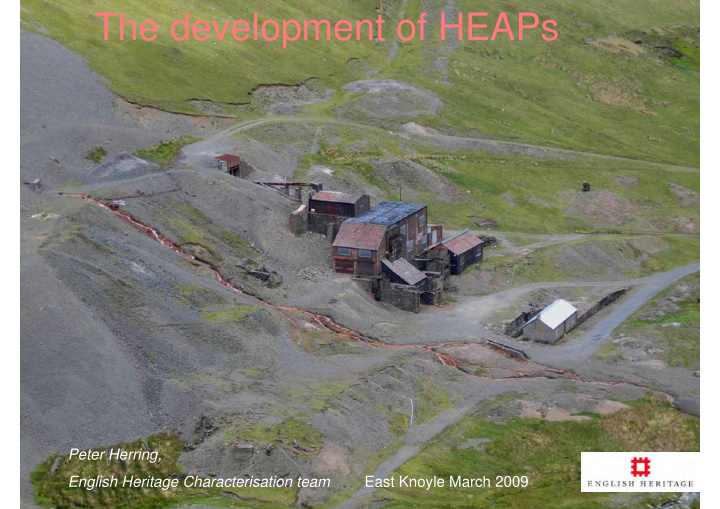



The development of HEAPs Peter Herring, English Heritage Characterisation team East Knoyle March 2009
Thinking about change It constantly affects the landscape, including those parts some see as ‘timeless’ or constant. Change Planned and considered, or unintentional Positive and enhancing as well as disturbing or damaging Perceptual as much as physical. Adjustments in understanding and meaning We cannot stop change, if defined so widely. But, we may determine to more deliberately and thoughtfully attempt to manage change, Taking into account the interests of all those with a stake in it.
• Understanding the past helps us go forward • Pass on ‘legibility’ to allow our successors to build identity, place and narratives from landscape, to see and understand the past
Two tools to help us use the past to guide future change Historic Landscape Characterisation HEAPs
Historic Landscape Characterisation (HLC). Identifying the predominant historic character of every part of a place. Using systematic sources and archaeological ways of seeing and thinking. Creating a framework of interpretation, of understanding, of meaning and of valuing. Every part can be cared for. HLC: A framework for action; a framework for Historic Environment Action Plans
HEAP = Historic Environment Action Plan Comparable with BAP ( = Biodiversity Action Plan) Biodiversity Action Plans assess • Current status and condition • Current factors affecting the species, community or habitat To create • Action plan objectives and targets; to maintain and to enhance • Implementation schedules Positive, proactive, productive….
First HEAP on Bodmin Moor, Cornwall, 2003 To inform debate on grazing levels on the Upland Rough Ground HLC type Stages 1 Understanding development and components of rough ground 2 Statements of significance 3 Forces for and effects of change Assessment of positive and negative impacts of three scenarios: Reducing grazing Increasing grazing No change 4 Objectives and targets
Main recommended action: Common by common accommodation of various interests. Based on HLC mapping.
Using Historic Landscape Characterisation Publication (2004) suggested stages in a HEAP 1: Refine characterisation 2: Character assessment & statements of significance Analysis & Assessment 3: Assess change & impacts Assess condition, historic change, processes and forces of change, impacts (positive and negative), vulnerability, risk 4: Strategies Objectives, options, targets 5: Actions (PDF version available on the English Heritage web site: www.english-
HEAPs now being developed by various local authorities West Berkshire
West Berkshire HEAPs Based on Historic Environment Character Zones, subdivisions of Historic Environment Character Areas (HLC plus archaeology and buildings) 1 Understand historic landscape character 2 Historic Environment / Archaeology 3 Historic Environment Potential 4 HEAP for: Conservation Issues Research Potential
HLC Broad Types The Isle of Wight County Archaeological Service HEAP Project Funded locally, via AONB, LEADER+ and Isle of Wight Council HEAP Areas, equivalent to West Berkshire HEC Areas
Two-year project: the most comprehensive HEAP programme so far undertaken Each HEAP Area and Type considered in greater detail than Cornish or Berkshire examples
Systematic format of the HEAPs for selected HLC Broad Types and each HLC Area • Historical overview – Typical components: archaeological sites, buildings, field and enclosure patterns, routeways, etc – Distributions of broad types and sub-types within HLC Areas – Links with biodiversity • Management issues affecting the type or area – Current protection and management • Objectives and targets • Proposed actions
Most important aspect of the IOW HEAPs project is the success of the Partnership approach Steering Group; regular, well-attended meetings Steering Group members provided extensive and targeted information and input Especially into management objectives and actions Wider stakeholders involved in selected events HEAPs also widely consulted on in Local Development Framework process including formal adoption by Isle of Wight Council And HEAPs incorporated into the public review of the Isle of Wight AONB Management Plan
Using HEAPs on IoW • Will inform – County Archaeological Service Strategy – Regional Research Frameworks – spatial planning and development control – landscape assessments, landscape management and agri-environment schemes • Will further improve partnership working • Will help make HLC information available to the Island community • Will feed into outreach and education initiatives
CCWWD AONB HEAPs A pilot project to develop methods of creating and using HEAPs in a protected area that has the benefit of formal management planning and numerous dedicated partners.
Recommend
More recommend